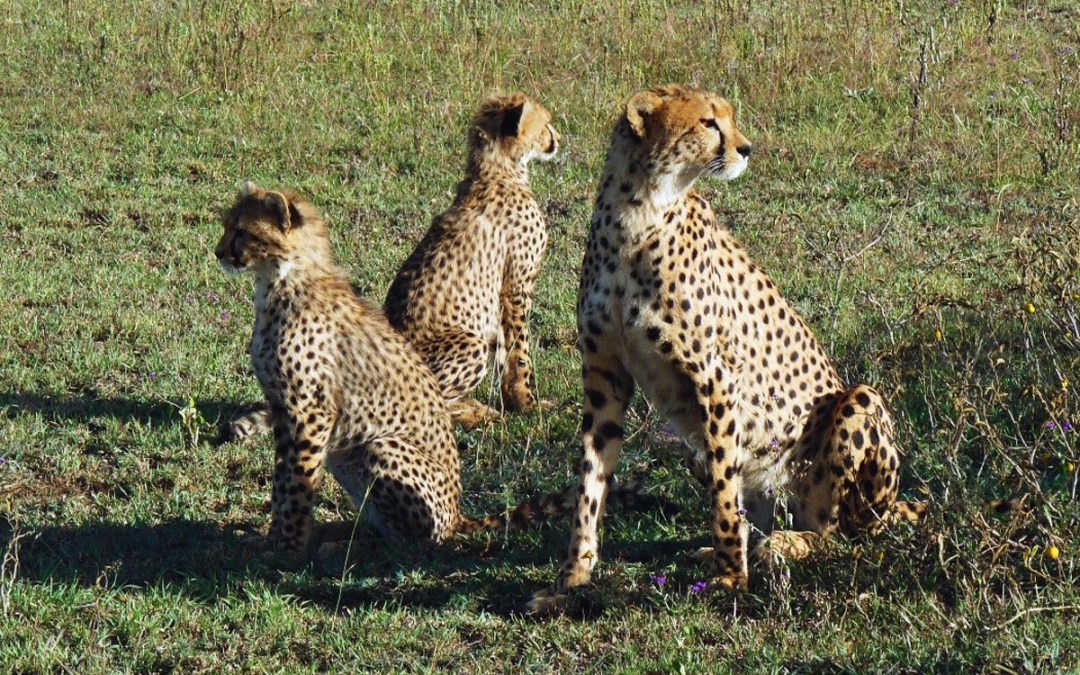Image: Mother cheetah with two cubs in Tanzania’s Ngorongoro Conservation Area © Keith Somerville
Professor Keith Somerville explores the decline of the cheetah, speed king of the cat family, and why more than a third of the entire wild population is located in Namibia.
It is estimated that, despite conversation efforts, only 7,100 of the world’s fastest land animal remain in the wild in scattered populations in 23 African countries and one, very small and possibly unviable population in Iran. The latter population number about 50 and is in severe danger of further decline and extinction.
In Africa, where numbers have steadily fallen, 79 per cent of the remaining populations contain fewer than 100 cats. However, in Namibia that figure is estimated at around 2,500, though it could be slightly higher. That is more than a third of the entire wild population and represents a significant rise from the 1,500 estimated in 1990, after decades of habitat loss, poaching, killing by livestock farming and poorly regulated hunting. How has this been achieved?
Namibia’s cheetah population – does it hold the key to survival?
Namibia has developed one of the more integrated and inclusive conservation programmes in Africa. This is not to say it is perfect and without continuing problems – human-wildlife conflict, poaching and loss of habitat. But it has the big plus of emphasising the involvement of local communities in decision-making over control of habitats and the species that inhabit them, and how to utilise wildlife to further conservation and develop livelihoods for the communities in arid areas with limited resources.
Namibia’s government and communities have been prepared, amid criticism from those who oppose hunting, to mix eco-tourism, full protection in national parks, regulated trophy hunting and game cropping in community-run conservancies and private game ranches or reserves, and this includes limited hunting on cheetah according to government-set quotas. The Convention on International Trade in Endangered Species of Wild Fauna and Flora (CITES) allows southern African cheetah to be hunted on the basis that the populations are still viable and will not be significantly reduced by regulated hunting, which provides income for local communities and wildlife departments.
Conservation in fully protected national parks has run alongside the community or private owned land and has been accompanied by government and local NGO education and conflict mitigation campaigns, often supported by international groups like Panthera.
The Hanssen family’s Africat and Africat North, and Dr Laurie Marker’s Cheetah Conservation Fund (CCF) have been at the forefront of education programmes, rehabilitating and relocating problem or injured cheetahs and developing conflict avoidance or mitigation strategies to reduce problems between predators and livestock farmers. This may involve supporting communities to build predator-proof kraals, encouraging herding practices that restrict losses to cheetahs and other predators during the day or providing sheepdogs that deter cheetahs and other predators – CCF has provided Namibian farmers with 650 Anatolian shepherd and Kangal livestock guard dogs.
Helping to avoid conflict between cheetahs and farmers is vital as 90 per cent of Namibia’s cheetahs live on unprotected land, most of it potential or actual grazing land. It is one of the most prevalent causes of cheetah deaths and is the main threat to the successes achieved since 1990 in restoring cheetah numbers and encouraging tolerance by farmers.
Nevertheless, many are still being killed (shot, trapped or poisoned), while others are caught. Groups like Africat or CCF are working hard to relocate the cats. Africat, as I found when I visited there in November 2017, is ramping up its education programmes and can also accommodate on its 22,000 acre reserve those cheetahs which can’t be relocated on farmland for various reasons.
Although populations in parks are protected, they number in the low hundreds and cannot achieve natural growth levels that would make up for losses among the vast majority on unprotected land.
It means that finding routes to peaceful coexistence and protection of habitats and prey are vital on community and private land. These must include both the conservation of cheetahs and empowerment and income generation for farmers if the habitats are not to be turned over to forms of farming that would mean the end for the world’s largest cheetah population.
A full version of this article can be read here
Professor Keith Somerville is a senior research fellow at the Institute of Commonwealth Studies, part of the School of Advanced Study, University of London. He is a Member of the Durrell Institute of Conservation and Ecology at the University of Kent where he teaches at the Centre for Journalism, and is editor of the Africa Sustainable Conservation News website.
More information

